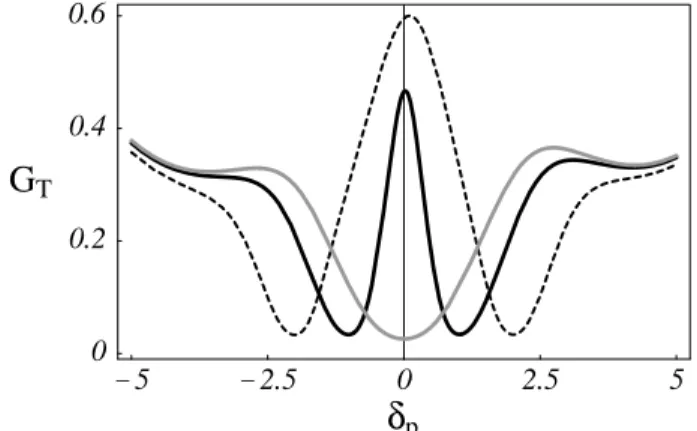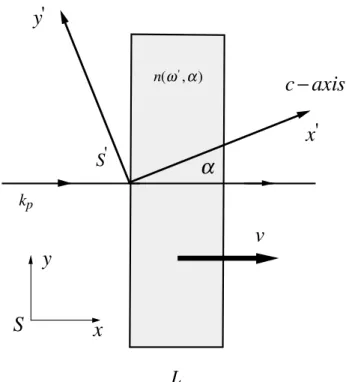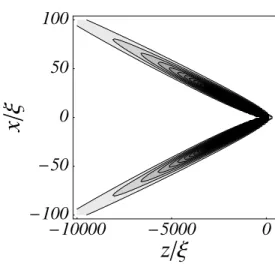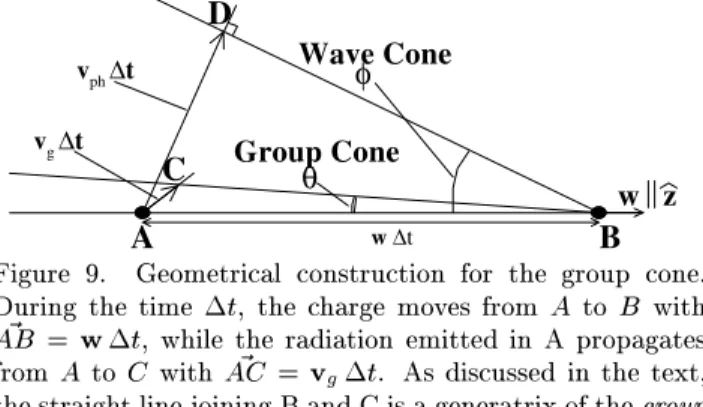The Regime of Eletromagnetially Indued
Transpareny in Optially Dense Media:
from Atoms to Exitons
M. Artoni a
, F. Bassani b
, I. Carusotto
, and G.C. La Roa d;b
a
INFMandLENS,LargoE.Fermi2,I-50125,Florene,Italy
b
INFM,SuolaNormaleSuperiore,PiazzadeiCavalieri,I-56126 Pisa,Italy
Laboratoire Kastler-Brossel, EoleNormaleSuperieure,75231Paris Cedex05,Frane
d
DipartimentodiFisia\E.R.Caianiello",Universita diSalerno,I-84081 Baronissi(Sa), Italy
Reeivedon23April,2001
The phenomenon of eletromagnetially induedtranspareny (EIT) was disovered by Adriano
Gozziniandoworkersin1976inPisa. NovelshemestoinvestigateandexploitEITintheoptial
domainhaveattratedmuhinterestbothinatomiand solidstate systems. Wedisusssomeof
ourreent theoretialresults,inpartiular: i) awelldevelopedEIT regimebasedonfreeexiton
levelsinundopedbulkrystallineCu
2
O;ii)light draggingeetsinmovingmediaunderEIT;iii)
theoherentontrolofCherenkovradiationintheEITregime.
I Introdution
In theontext ofoptial pumpingexperimentson Na,
Adriano Gozzini and oworkersobserved for the rst
time in 1976 in Pisa a peuliar phenomenon:
when-evertheseparationamongtwoZeemansublevelsofthe
twohyperneomponentsofthe3Sgroundstatewould
equalthefrequenydierenebetweentwolasermodes
nearlyresonantwith theD
1
line, noabsorptionwould
beindued,andthereforenouoresenefrom the3P
levelwouldbeobserved, asif Nawould be
\transpar-ent"totheresonantlight. Thisphenomenon,originally
referredtoastheNa\blakline",wasimmediately
ex-plainedbyEnnioArimondoetal. intermsofquantum
oherene and interferene whereby the ground state
doublet ispumped intoaoherentsuperposition state
where thepopulationistrapped duetodestrutive
in-terferene between the two distint paths of
absorp-tion to the third exited level. After these seminal
works [1℄, suh a mehanism of oherent population
trappingunderlyingeletromagnetiallyindued
trans-pareny(EIT)hasreeivedinreasingattention[2℄
be-ause of the many appliations, suh as for instane
subreoillaser ooling[3℄, lasingwithoutinversion[4℄,
adiabatitransfer[5℄. Morereently,bothinultraold
atomiloudsaswellasinsolids,EIThasbeenshown
to open novel regimes of the eletrodynamis of
on-tinuous media. We here present some of our reent
theoretialresults: inpartiular, awelldevelopedEIT
regime based on free exiton levels in undoped bulk
rystalline Cu O [6℄; light dragging eets in moving
mediaunderEIT[7℄;and,in moredetail,theoherent
ontrolofCherenkovradiationintheEITregime.
II EIT for intrinsi bulk exiton
lines
The investigation of fundamental oherent optial
ef-fets in semiondutors is an important eld of
re-searhwherequantuminterfereneplaysarole: weare
hereonernedwitheletromagnetiallyindued
trans-pareny (EIT), so far demonstrated mostly for dilute
atomivapors. Condensedmatterexhibits quitea
va-riety of three-level systems where EIT ould also be
realized. Yet dephasings, whih an easily break the
oherene of the population trapping state, make it
diÆult to observe a large EIT eet in solids. For
mirowaves, EIT has been observed in ruby [8℄ using
astrong externalmagneti eld, while in the infrared
EIThasbeenobservedinintersubbandtransitionsina
quantumwell[9℄. Foroptialfrequenies,EITinsolids
hasonlybeenobservedin an inhomogeneously
broad-enedhole-burningPr3+-dopedY2SiO5rystal[10℄. We
predit a remarkable enhanement of
eletromagneti-ally indued transpareny in an undoped bulk
semi-ondutorexhibiting sharp free-exitonlines that
or-respond to intrinsi deloalized eletroni states. We
speiallyonsiderthe\yellowexiton"seriesinCu
2 O
forwhihalltherelevantspetrosopiparametersare
available[11,12℄.
ourat the point(O
h
symmetry)andhave,
respe-tively, +
6 and
+
7
symmetry, eah twofolddegenerate
spininluded. Thefour statesofthe 1S exiton
man-ifold split into an upper quadrupole allowedthreefold
degenerate +
5
level and a lowerforbidden
nondegen-erate +
2
level. The twelve states of the 2P exiton
manifold are lassied aording to their symmetries
as follows:
2
3
4 2
5
, among whih only
the threefold degenerate
4
states are dipole ative
and giverise to the seond lass 2P \yellow exiton"
line [13℄. In thefollowing, weassumethat the
4
op-tially ative2P states aresuÆiently separatedfrom
allothers sothatweanrestritourselvesonly tothe
+
5
1S and
4
2P exiton states. The
longitudinal-transverse splitting of the seond lass 2P exiton is
negligible. The inlusion of the omplete 2P exiton
manifold [14℄ would not hange signiantlythe main
resultsheredisussed.
We are interested in the optial respone
experi-ened by a weak probe beam of frequeny !
p tuned
around the 2P \yellow" exiton line of resonant
fre-queny !
2P
, while a strong oupling beam of
fre-queny !
and Rabi frequeny
is nearly resonant
with the 1S to 2P exiton transition of resonant
fre-queny!
2P 1S =!
2P !
1S
. All relevantparameters
intheeetivehamiltoniandesribingthisthree
ex-iton level onguration an be determined from the
usual envelopefuntion pitureof Wannier-Mott
exi-tonstates. Thedipole forbidden1S exitonstate has
asmall linewidth (~
1S
'0:1 meV)ompared to that
oftheseondlassallowed2P exitonstate(~
2P '1
meV) and awell developed EIT anbeestablished in
the presene of the oupling beam. A transpareny
window about the 2P exiton line appears, while for
very high pump intensities, or at least for
larger
thanabout2
2P
,theAutler-Townesregimeis
eventu-allyreahed[2,12, 6℄. Theoptialsuseptibility
expe-rienedbyaprobepolarizedalongxinthepreseneof
apump polarizedalongy isgivenby
p =
A
2P (Æ
p Æ
i
1S )
(Æ
p i
2P )(Æ
p Æ
i
1S
)
2
=4
;
with A ' 0:02 is a numerial onstant proportional
to the 2P exiton osillator strength[6℄ whereas Æ
p =
!
2P !
p and Æ
= !
2P 1S !
are the two relevant
detunings.
Fig.1 shows the imaginary part of the
suseptibil-ity for pump intensities haraterizing both EIT and
Autler-Townes regimes for a probe tuned to the 2P
exiton line. The atual transmission through aslab,
inludingthe eet ofthe omplexbakground
diele-tri onstant, is shown instead in Fig.2 antiipating a
nearly 50%transmission due to EIT. Apart from the
bakground absorption, the 1S exiton linewidth
1S
isthematerialparameterthatmostlylimitsthe
possi-bility of ahieving even largerEIT eets in this
sys-eters appropriate to the experiments by Frohlih and
oworkers[12℄whereaverytinyEITeetouldindeed
bereognized: this gurereprodueswellthe
dieren-tialtransmissionmeasuredin[12℄foranearlyresonant
pump.
-
5
-
2.5
0
2.5
5
δ
p
0
0.005
0.01
0.015
0.02
χ
p
″
Figure1. Imaginarypartofthesuseptibilityvs. theprobe
frequenydetuninginunitsof 2P foraresonant oupling
beam. TheouplingRabifrequeniesare=2P =2(solid)
and4(greydash)whileintheabseneoftheouplingbeam
( = 0) the suseptibility is desribed by the solid grey
urve.
-
5
-
2.5
0
2.5
5
δ
p
0
0.2
0.4
0.6
G
T
Figure 2. Transmission oeÆient GT vs. the probe
fre-quenydetuninginunitsof2P;thebakgrounddieletri
onstantis1=6:5+i210 3
,theslabthiknessd=35m
whiletheotherparametersarethesameasinFig. 1.
-
0.5
-
0.25
0
0.25
0.5
δ
p
0.002
0.003
0.004
0.005
0.006
0.007
G
T
Figure 3. Same as in Fig.2 exept for a slab thikness
d=60m, a oupling Rabi frequenies =2P = 0.2, and
TheobservationofafullydevelopedEITregimefor
intrinsi exiton lines in semiondutors would open
the wayto many opportunities involvingeither devie
appliationsofEITorfundamentalissuessuhas,e.g.,
the role of polaritoni eets and of ponderomotive
fores intheEITontext.
III Fresnel light drag under EIT
Thephaseveloityoflightdependsonwhetherlightis
propagating in a moving or in a stationary medium.
This eet, whih gives rise to the familiar Fresnel
light{drag[15℄, hasbeenobservedfortherst timein
Fizeau's owingwaterexperiment[16℄ andhad a
pro-found inueneonthehange ofourpereption ofthe
nature of spae and time at the turn of the entury.
Severalotherobservationsoflight{dragshavefollowed
inwhihdierentdraggingmediaanddierent
interfer-ometri measurementtehniqueshavebeenemployed.
Therestillremains,however,aformidablehallengeto
performhigh-preisionmeasurementsoflight{dragsas
theyhavenotyetreahedthelevelofaurayofother
tests ofspeialrelativity[17℄.
Inorder to perform ahigh{preision measurement
of theFresnel-Fizeaueetoneneeds ratherhigh
sen-sitivity to veloity indued phase shifts whih means
largesamplespeeds. Atthesametime,inorderto
pre-servehighontrastoftheinterferenefringepattern,
vi-brationstransmittedfromthesamplemovementtothe
interfereometeritselfhavetobeminimized. Tothis
ex-tentwehereantiipatethatpreisionanbeimproved
throughEIT whenthisisdevisedto ourin aslabof
uprousoxide(Cu
2
O)usedasadraggingmedium.
Im-provementsonsistinquitelargepositiveandnegative
light{drags that enable one to ahieve high
interfero-metri sensitivities evenfor lowdrag veloities. Large
drags are assoiated with the steep dispersion
our-ringwithin atransparenywindowenteredat the2P
exitonresonaneandarisingfromthequantum
inter-fereneinaspeipump{probeongurationwhih
involvestheground,the1S andthe2P exitonlevels,
asshownabove.
Not onlyan oneinreasepreision,but in a
sam-ple rendered anisotropi by a suitable hoie of the
pump polarization onean also make the phase shift
orrespondingtothe light-dragto vanish. This means
that in a typial interferometri experimentno fringe
shift would be observedfor lightpropagating through
the movingmedium with respet to lightpropagating
throughthemediumatrest. Thissomewhatsurprising
onlusionholdsforallveloitiesofexperimental
inter-estwhiletuningofthelight{dragtozeromayturnout
to bequite favorable forinvestigatingthe
eletromag-netiandmehanialbalaneofthemomentum
assoi-We then examine Cu
2
O under EIT as dragging
medium and look at the Fresnel drag experiened by
aweakprobebeamoffrequeny!tunedaboutthe2P
\yellow"exiton lineof resonantfrequeny!
2P , while
astrong beam of Rabi frequeny
is resonant with
the1S to2P exitontransition. Forapump Rabi
fre-queny
p
2P
1S
EITtakesplaewherebya
nar-rowtransparenywindowwitharathersteepdispersion
appearsaroundthe2P exitonline.
Theeetive dieletritensorseenby theprobein
thepresene ofthepumpis ingeneralanisotropi,
de-pending onthepumppolarizationandonthedetailed
strutureoftheexitonlevelsinvolved. Forthesakeof
simpliity, wehereassumethat the
4
statesarewell
separatedfrom all other 2P statesand the pump
po-larizationis along the ubi axisx^ 0
(See Fig.4). The
resulting dieletri tensor is uniaxial with the optial
-axis alongx^ 0
, i.e.,
x 0
x 0 =
k ,
y 0
y 0 =
z 0
z 0 =
? and
j 0
6=k
0 =0andforaresonantpumpbeamonehas
? =
EIT =
1 +
A
2P (Æ
p i
1S )
(Æ
p i
2P )(Æ
p i
1S
)
2
=4
;
while
k
is obtained by setting
! 0 in the above
equation.
α
v
c
−
axis
x
y
S
x
'
y
'
S
'
L
n
(
ω
'
,
α
)
k
p
Figure4. ProbebeampatharossaCu2Oslabmovingwith
veloityvinthelaboratoryframeS. Theprobewavevetor
k
p
, the slabveloity and itssurfae normal are all in the
samediretionx.^ Thepumpisdiretedalong^z=z^ 0
andits
polarizationisparalleltotheoptialaxis^x 0
whihmakesa
xedanglewithx.^
In a typial onguration [18, 17℄ a slab of
on-thelaboratoryframeSasskethedinFig.4. The
quan-tityofexperimentalrelevaneistheveloitydependent
phase-shift experiened bytheprobeuponsingle{
pass transmission. We do not aount here for small
tilt angles between the surfaenormal and the avity
axisx^employedinpratie[17℄toavoidmultiple
ree-tions. We givethephase{shiftfor aprobesingle{pass
at normalinideneasitissuÆienthereto illustrate
the eet of frequeny and angular dispersion
assoi-atedwithEIT onthelight{drag.
The shift is arelativisti invariantand anbe
onveniently evaluated in the slab rest frame S 0
.
Un-der EIT thedispersionequation for aprobe polarized
in the x 0
y 0
plane is that of an extraordinary ray [19℄
whoseomplexrefrativeindexisgivenby
n 2
(! 0
;)=
k (!
0
)
1+
r (!
0
)os 2
;
r (!
0
)
k (!
0
)
? (!
0
) 1;
withn 0
andn 00
respetivelyitsrealandimaginaryparts.
Inthelaboratoryframethesingle-passphaseshift,
in-ludingontributionstorstorderin,anbewritten
as[7℄
'
0
!L
1 n 0
(!; ) ! n
0
(!; )
!
0
!L
d ;
where
0
orresponds to the shiftindued by a
sta-tionaryslaband
d
representstheeetivephaseshift
oeÆient in termsof the probelaboratoryframe
fre-queny!. The usualdenition [20℄ of thedrag
oeÆ-ientforthephaseveloityoflightanberelatedtothe
measurablequantity
d
[14℄. OwingtoEITthe
absorp-tive partn 00
onlyappearsasahigher{orderorretion
to andanthereforebenegleted.
ThemagnitudeandsignoftheoeÆient
d anbe
ontrolled through the leavageangle and the
ou-pling beam Rabi frequeny
. In the following, we
disussnumerialresultsforaresonantpump.
0
0.5
1
1.5
2
Ω
c
-
15
-
10
-
5
0
5
10
15
20
α
e
a
Figure5. CoeÆient d vs. inunitsof2P fora
reso-nantprobe rossingaCu2O slab. Heretheleavage angle
is'5 o
and2P =1meV.
-
1.5
-
1
-
0.5
0
0.5
1
1.5
δ
p
-
20
-
10
0
10
20
α
e
b
Figure 6. CoeÆient d vs. Æp inunitsof 2P for a Rabi
frequenyof=2P =0.18(solid),0.7(dash)and0(grey).
TheotherparametersarethesameasinFig.5.
Fig.5 shows the variation of
d
as a funtion of
for a resonant probe. Notie that
d
vanishes at
~
' 0:18 meV but an be as large as 17, that is
over one order of magnitude larger than the
d 's of
dragging glasses [17℄ typially used for high{preision
measurementsoftheFresnel{drag. Thisnoveland
im-portant feature is due to the anisotropy and to the
strongdispersionbothharateristioftheEITregime.
Fig.6 shows instead the variation of
d
as a funtion
of the probe detuning for xed pump intensities.
Be-ause of EIT, transmission is quite largein the range
jÆ
p
j < 0:5
2P
; for a slab thikness L = 25m this
varies between 10 30 % despite the 2P exiton
resonane[6℄. Apart from the bakground absorption,
the 1S exiton linewidth
1S
is the material
parame-ter thatmostlylimitsthepossibilityofontrollingthe
magnitudeof
d
throughEIT.
IV Cherenkov radiation in the
EIT regime
Thereentobservationof ultraslowgroupveloities in
oherentlydrivenmedia[21,22,23℄hasopenedtheway
towardsnewregimesoflightpropagation[24℄andnon{
linear optis at very weak intensities [25℄. Here, we
investigate the eet of ultraslow group veloities on
the Cherenkov radiation emitted by a harged
parti-le uniformly moving with a veloity larger than the
phase veloity of light. In the ase of isotropi and
non-dispersivemedia, thesurfae on whih the
inten-sitypeaksoinideswiththewellknownwaveone
or-thogonaltothewavevetoroftheemittedlightandthe
apertureofwhihisdeterminedbytheusualCherenkov
oherene ondition. In the ase of highly dispersive
media,asweshowhere,theintensityisinsteadpeaked
on thesurfaeof agroup one [26℄ neither orthogonal
to thephase nor to the groupveloity of the emitted
developageneraltheoryforCherenkovemissionin
ar-bitrarydispersiveand non-isotropimediafrom whih
we obtain analytial expressions for the eletri eld
intensity proleand, in partiular, for the group one
aperture. Then, asanexample,weinvestigatethe
op-tial properties of an ultraold atomi loud of 23
Na
atomsintheEITregimewhihappearstobeamenable
to theobservationofsuhasingularbehaviour.
Considerahargedpoint-likepartile moving with
onstant veloity w = w^z = ^z through a
non-absorptiveandhomogeneousmedium haraterizedby
an anisotropiand dispersivehermitian dieletri
ten-sor (!)^ =
i;j
(!). The eets of a weak absorption
will be onsidered afterward for the ase of interest.
UsingMaxwellequationsinFourierspae,wewritethe
(k;!)omponentoftheradiated eletromagnetield
E(k;!) in terms of theorrespondingFourier
ompo-nentsoftheurrentdensityJ(k;!)=2qÆ(! kw )w
as
E(k;!)= 4i! 2 k 2 ^ P k ! 2 2 ^ (!) 1
J(k;!) (1)
where ^ P k i;j =Æ i;j k i k j k 2
istheprojetionoperatoronto
the subspaeorthogonal to kand k 2 = P i k i k i is the
squaremodulusofk.
Thepolesof(1)determinethepropagatingmodesof
theeletromagnetield throughthewell-knownF
res-nel equation[20℄
k 2 ^ P k ! 2 2 ^ (! ) e ()
=0: (2)
Foreahwavevetork,thedierentmodesare
hara-terized by the frequeny!
and the polarization unit
vetore ()
normalizedashe () je () i= P i e () i e () i =
1. Wewillnotaounthereforlongitudinalmodes,
as-suming ! 2
6= 0 and det [ ^(!)℄ 6= 0 for all values of !.
Foreahmode,thegroupveloityanbeshowntobe
v () g =r k ! = 2 2k e () he () jki e () hkje () i e () ! (! 2 ^ (!)) e () : (3)
This expression for v
g
orresponds to theratio of the
Poynting vetor Sand the energy density u [20℄. We
shall alsorestritourattentionto thesimpleaseofa
mediumwithrotationalsymmetryaroundthediretion
ofthehargeveloity;inthisase,therevolution
sym-metry of thedispersionsurfae!
(k)= ! guarantees
theparallelismoftheomponentsofthegroupveloity
andthewavevetorperpendiularto the^zaxis.
The eletri eld at a position x = (x
? ;z) =
(x
? ^ u
?
;z) an be obtained from the inverse Fourier
transform of (1). At suÆiently large distanes from
the hargetrajetory, onlythe poles of (1) eetively
ontributeto the Fouriertransform. Infat, the
ele-trieldatthesedistanesisgivenbytheresonant
ex-itation ofpropagating modes, whilethenon-resonant
ontributionfrom allother modes deays outin spae
with a faster power law. In the eletri dipole
emis-sion,asimilardistintionisdonebetweenthenearzone
(kr1)andtheradiationzone(kr1). Withinsuh
anapproximationweanwrite forthei th omponent, E i (x ?
;z;t) = 2iq 2 Z 1 0 d! X =1;2 k () ? !he ()
jw i^
s i 2k () ? x ? e ik () ? x ? e i ! w (z wt) e () i (4)
Here,w^ =w =wisthediretionofthehargeveloityw
and = e () k ? k 2 ^ P k e ()
is aweight fator.
Inobtainingtheexpression(4)theangularintegration
in k
?
has been already performed in the large k
? x
?
limitsothat, foreahpositionx
?
, onlytheeld
om-ponentswithk
?
paralleltox
?
haveastationaryphase
and therefore give anonvanishing ontribution to the
integral.
α
=1
α
=2
k
z
k
k
z
=
ω
/ c
β
3
k
z
=
ω
/ c
β
2
k
z
=
ω
/ c
β
1
Figure7. Shematiplot ofthe longitudinal ross setion
ofthedispersion surfaesfor thetwopropagating=1;2
modesatagiven!.Thevertiallinesaretherosssetions
ofthe kz =!=planes. For =1,noCherenkov
radi-ationoursat !;=2 isthe thersholdveloity for the
=1mode;for =3,bothmodesareexited.
Depending on theveloity of theharged partile,
for eah diretion u^
?
and frequeny !, at most two
distint poles at k ()
?
( = 1;2) ontribute to the
in-tegral, whih orrespond to propagating modes with
wavevetork () =(k () ? ^ u ?
;!=w)andpolarizatione ()
.
As shown in Fig.7, at agivenfrequeny ! Cherenkov
lightisemittedinto themodeonlyifthek
z
=!=
planehasanon-vanishingintersetionwiththe
disper-sionsurfae !
(k) =! ofthe mode. Inthe aseof a
mediumwithrotationalsymmetry,thisonditionis
sat-isedifthepartileveloityexeedsthephaseveloity
ofmodeforkparallel tow ,i.e.
and the intersetion is the k
? = k
()
?
irle. Here
()
?
(!) are the eigenvalues of the dieletri onstant
in the plane perpendiular to the ^z axis. For an
isotropimedium,theondition(5)reduestotheusual
Cherenkovondition 2
(!)>1 [27℄.
Thetheorydevelopeduptonowhasonsideredthe
ase of a non-absorptive medium for whih the poles
k ()
?
are real; the eet of aweak absorption onsists
in the introdution of a small and positive imaginary
partIm[k ()
?
℄intheargumentoftheexponentialin(4)
without modifying the pole struture of the integral.
Theresultingdampingfatore Im[k
()
? ℄x
?
aountsfor
absorptionoftheemittedradiationduringpropagation.
We now onsider a medium with a narrow
trans-parenywindowenteredat!; forasinglepolarization
state=1,theabsorptionfatorin theneighborhood
of!anbeapproximatedbyIm [k (1)
? ℄'
2 (! ! )
2
with
=
2
Im[k (1)
? ℄=!
2
. Insertingthisexpression into(4),
wenally obtainanexpliitexpressionfor theeletri
eld intensityprole
jE(x;t)j 2
= Aq
2
x 2
? exp
"
1
x
?
z
w +
x
?
v
r t
2 #
he (1)
j ^
w i
2
; (6)
d
wheree (1)
isthepolarizationvetorofthemodeat
fre-queny! and A=4k (1)
? ! 2
= 4
2
1
. Theradialveloity
v
r
isdenedaordingto
v 1
r =
"
k
?
!
k
z =
!
w #
= w v
k
g
wv ?
g
(7)
wherev ?
g andv
k
g
arerespetivelytheperpendiularand
parallelomponentsofthegroupveloityv (1)
g
with
re-spettothediretionw^ =w =wofthehargeveloity.
AsitanbeobservedinFig.8,suÆientlyfarfromthe
harge, i.e. at points x
?
=v
2
r
, the eletrield
intensity(6)ispeakedonthegroup onedesribedby
x
?
v
r +
z
w
=t (8)
whoseaperture isequalto
tan=v
r
=w: (9)
Ingeneral,isdierentfromtheapertureofthewave
one orthogonalto the wavevetorsof theemitted
ra-diation,whih isinsteadgiven by tan=!=wk (1)
? . A
simplephysialinterpretationofthegrouponeanbe
put forward in terms of group veloity [26℄
onsider-ingthat,foreahdiretion aroundthehargeveloity,
the burst of Cherenkov light is emitted into a group
of modes entered at k (1)
while thepeak of the pulse
movesin spaewith a veloity equalto the group
ve-loity v (1)
g
experiening an almost negligible
absorp-tion. The one dened by this geometrial
onstru-tion(Fig.9)anbeproveninallasestobeequivalent
to the groupone dened by (8) and to oinide, for
the aseof an isotropi medium, with the groupone
introdued byFrank[26℄. Notie that this one turns
out to be in general neither orthogonal to the group
veloitynortothewavevetor. Intheaseofisotropi
and non-dispersive media, in whih v
g = v
ph =
^
k,
n being the refrative index, the groupand the wave
ones oinide and have anaperture dened by the
usualCherenkovonditionnsin=1.
The weak dispersion of ommon dieletris makes
the dierene between the group and the waveones
verysmalland haspreventeduptonowits
experimen-tal observation [26℄. Whenthe groupveloityis muh
smaller than the phase veloity the groupone is
ex-petedto bewellseparatedfromthewaveone(g.9)
and to have an extremely narrow shape 1.
Fol-lowingthereentobservationsofultraslowlightin
o-herentlydrivenhot[21,22℄andold[23℄atomigases,
suhmediaappearaspromisingandidatesforthe
ex-perimentalharaterizationoftheroleofgroupveloity
in Cherenkovradiation.
10000
5000
0
z
Ξ
100
50
0
50
100
x
Ξ
Figure 8. Intensity ontour{plotof the longitudinal
ross-setionofthegroup oneatt=0forv ?
g
A
B
C
D
w
∆
t
v
g
∆
t
Group Cone
Wave Cone
θ
w z
φ
v
ph
∆
t
Figure 9. Geometrial onstrution for the group one.
During the time t, the harge movesfrom A to B with
~
AB =wt, while the radiation emitted inA propagates
from A to C with ~
AC =v
g
t. As disussed inthe text,
thestraightlinejoiningBandCisageneratrixofthegroup
one.
Weonsider aloud of ultraoldatoms in a
three-level-typeongurationunder EITregime. In usual
EIT experiments the eet of Doppler broadening in
hot gasesis overome byhoosing a dressingeld
o-propagatingwiththeprobeeld[2℄;unfortunately,the
onialgeometryofCherenkovemissiondoesnotallow
for suh ahoie, sothat oneis hereforedto use an
ultraold sample in whih Doppler broadening is
ab-sent. Wetake,asaspei example,the aseof 23
Na
atoms (Fig.10) magnetiallytrapped in theM
F = 1
sublevel of the F
g
= 1 ground state. Let !
g
be the
frequeny of suh a state. The other hyperne
om-ponent of the S
1=2
groundstate is a metastable state
withF
m
=2approximately1:8GHzblue-detunedwith
respettothegroundstate. Aweak oherenteld
po-larized along the trap magneti eld drives the
opti-al transition from themetastablestatetothe F
e =2
hyperne omponent of the P
1=2
exited state. Its
Rabi frequeny is smaller than the exited state
linewidth
e
'210MHzwhileitsfrequenyistaken
tobeexatlyonresonanewiththetransitionbetween
the M
F
= 0 Zeeman omponents !
dr = !
e [M
F =
0℄ !
m [M
F
=0℄. Assumingthe hargeveloity tobe
parallel tothetrapmagnetield,therotational
sym-metryofthesystemaroundthe^zaxisimplies[28℄ the
followingdeompositionofthedieletritensor^(!)=
z
(!)j^zih^zj+
+ (!)j^
+ ih^
+
j+ (!)j^ ih^ j. For
eahfrequeny!anddiretion ^
k,thetwopropagating
modesdened by(2) aregenerallynon-degenerate
ex-eptathighsymmetrypointsandhaveelliptial
polar-izations;fromthepointofviewofthespatialsymmetry
oftheoptialonstants,thepolarizedatomiloudisin
fat not onlyuniaxial, but alsooptially ative. Sine
thelinewidth
m
ofthemetastablemstateisordersof
magnitudesmaller[23℄thanthatoftheexitedestate
e
,eletromagnetiallyinduedtranspareny(EIT)
o-ursonthe^
+
polarizationinanarrowfrequeny
win-dow of linewidth = 2
=
e
e
around !
+ =
!
e [M
F
=0℄ !
g
[2℄whereabsorptionisquenhedand
dispersion enhaned so asto give slowlight
propaga-tion. Inthesamefrequenywindow!'!
+
,the
tran-sitionsfromthegroundstatetotheM
F
= 2; 1
sub-levelsoftheexited statearesuÆientlyo-resonane
(!
z; = !
e [M
F
= 1; 2℄ !
e [M
F
= 0℄
e ) so
astogiveapositiveandrelativelyfrequeny-at
bak-groundontributiontothe^ and^zomponentsofthe
dieletritensor
+
= 1+
4f
+
!
+ i
e !
jj 2
!
+ i
m !
(10)
z;
= 1+4 1
z;
=1+ 4f
z;
!
z;
: (11)
The osillator strengths f
;z
are proportional to the
atomidensitytimes thesquareof thedipole moment
oftheoptialtransitionanddierfrom eah other
de-pending on the relevant Clebsh-Gordan oeÆients.
Thedetunings!
z;
followfromtheZeemansplitting
oftheatomilevels,whihimpliesthatthebakground
refration anbe experimentally ontrolled by tuning
themagneti eld; with 23
Na atoms, a splitting !
of about240MHzours in a reasonablemagneti
eldoftheorderof80G. Giventhedierentmagneti
moments of metastable and exited states, the weak
dressingeldannoteetivelydresstheoptial
tran-sitionsotherthantheresonantonebetweentheM
F =0
sublevels. Thanksto theirlargedetuningwith respet
to!
+
,alltransitionsinvolvingtheotherhyperne
om-ponentsoftheexitedstateanbenegleted.
P
1/2
(F=2)
S
1/2
(F=2)
S
1/2
(F=1)
Ω
σ
+
z
σ
−
−2
−1
0
1
2
M
F
g
m
e
Figure10. Shemeofthe 23
Naatomilevelsinvolvedinthe
optialproessunderexamination.
The threshold veloity (5) for Cherenkov emission
at !
+
is determined by the bakground refrative
in-dex (11). If the veloity is larger than the threshold
value,lightisradiatedintoamodewithnon-vanishing
k (1)
?
; in presene of EIT, suh aradiation will
propa-gate with ultraslow group veloity without being
ab-sorbed. The magnitude of the group veloity (3) is
mainlydeterminedbythedispersivepropertiesofEIT
whileitsdiretiondependsonthebakgroundrefrative
index only. Group veloities aslow as17m/se have
beenreportedin anultraoldsodiumgas[23℄and this
means that the group one would have an extremely
narrow shape, pratially a ylindrial one ( 1).
From theparameters of [23℄,the harateristi length
=v 2
r ' v
?2
g
turns outof the order of 10m and
thebakgroundsuseptibility4 1
10 2
, i.e. muh largerthan that usually found in gas
Cherenkovounters[27℄.
Thetheory wehave developed is basedon the
as-sumption of a homogeneous medium. This
approxi-mation is reasonable provided the overall size of the
atomiloudismuhlargerthanthewavelengthofthe
Cherenkov lightwhose detetion should be performed
within theloud itself so to avoid reetion eets at
the edges of the loud. For the aseof EIT media, a
piture of thegroup one an betaken exploiting the
verylargerosssetionforresonanttwo-photon
absorp-tion proesses [30℄: the absorption oeÆient
experi-enedbyalasereldonresonanewithanotheroptial
transition starting from the M
F
= 0 sublevel of the
metastable m state is in fat proportional to the
lo-al intensity of the Cherenkov radiation at !
+ whih
forms the narrow group one [25℄. Sine the
intera-tion ofthe hargewith the atoms of theloud results
notonlyonCherenkovemissionbutalsoonother
heat-ing andionization proesses[20℄, itis neessaryto
re-due the importane of suh short-range proessesby
makingthehargetravelinaregionofspaefreefrom
atoms. For the ase of an atomi loud, this an be
ahievede.g.byusingtherepulsivepotentialofa
blue-detunedlasersoastoreateasortof\tunnel"through
theloud;asmallylindrialholewitharadiusofthe
order of the wavelength does redue the yield of the
Cherenkov radiation, but does not aet the
qualita-tivefeaturesoftheCherenkovpulsepropagatinginthe
surroundingmedium [29℄. Unfortunately,theintensity
oftheCherenkovradiationemittedbyasingleeletron
isratherlow. Forthe 23
Naparametersandstatistially
independenteletrons,aphotonisemittedinthemode
under onsideration eah 10 7
eletrons. This problem
may be overome by looking at the eletrield
gen-erated by averylarge numberof eletronsat a time:
sine the radial veloity v
r
is muh smaller than the
harge veloityw, the proleof thegroupone would
notbesmearedoutevenifthespatialextensionofthe
bunhof eletronsismuhlongerthanthewavelength
oftheemittedlight.
Unlike in isotropi and non-dispersive media, the
grouponeis heremuhnarrowerthan thewave one
denedbytheusualCherenkovohereneonditionand
isneitherorthogonaltothephasenorthegroup
velo-ity. Thisoneptualdistintionbeomesofgreat
physi-alrelevaneinmediaexhibitingslowlightpropagation.
For the realisti ase of a oherently driven ultraold
23
Nagas, thegeometrial and dispersivepropertiesof
thedieletritensorare shownto befavourabletothe
experimental haraterization ofthe role of the group
veloityin theproessof Cherenkovemission.
Referenes
[1℄ G.Alzetta,A.Gozzini,L. Moi,G.Orriols,Nuovo
Ci-NuovoCimento17,(1976)333.
[2℄ S.Harris, Physis Today50,(1997)36; E.Arimondo,
Progress in Optis XXXV, Ed.E. Wolf (Elsevier
Si-ene,Amsterdam1996)257; andreferenestherein.
[3℄ A.Aspet,E. Arimondo,R.Kaiser, N.Vansteenkiste,
C.Cohen-Tannoudji, Phys.Rev.Lett.61,826(1988).
[4℄ A.S. Zibrov, M.D.Lukin, D.E.Nikonov, L. Hollberg,
M.O. Sully, V.L. Velihansky,H.G. Robinson, Phys.
Rev.Lett.75,1499 (1995).
[5℄ K. Bergmann, H. Theuer, B.W. Shore, Rev. Mod.
Phys.70,1003 (1998).
[6℄ M. Artoni,G.C. LaRoaandF.Bassani,EuroPhys.
Lett.s49,(2000)445.
[7℄ M. Artoni, I. Carusotto, G.C. La Roa, F.Bassani,
Phys.Rev.Lett,86,2549 (2001).
[8℄ Y.Zhao,C.Wu,B.S.Ham,M.K.Kim,andE.Awad,
Phys.Rev.Lett.79,(1997)641.
[9℄ G.B.Serapiglia,E.Parpalakis,C.Sirtori,K.L.
Vodopy-anov,C.G.Phillips,Phys.Rev.Lett.84,(2000)1019.
[10℄ B. S. Ham, M. S. Shahriar, and R.P. Hemmer, Opt.
Lett.s 22, (1997) 1138; K. Ihimura, K. Yamamoto,
andN.Gemma,PhysRev.A58,(1998)4116.
[11℄ S. Nikitine, J.B. Grun, M. Sieskind, J. Phys. Chem.
Solids17,(1961)292;Landolt-Bornstein,seriesIII,17
(Semiondutors),(Springer,Berlin,1984).
[12℄ D. Frohlih, A. Nothe, and K. Reimann, Phys. Rev.
Lett. 55,(1985) 1335; D. Frohlih,Ch. Neumann, B.
UebbingandR.Wille,phys.stat.sol.(b)159,(1990)
297.
[13℄ F.BassaniandG.PastoriParraviini,EletroniStates
and Optial Transitions in Solids (Pergamon Press,
Oxford 1975); P. Yu and M. Cardona, Fundamentals
ofSemiondutors (Springer,Berlin1996).
[14℄ M.Artonietal.,tobepublished.
[15℄ A.Fresnel,Ann.Chim.Phys.9,57(1818).
[16℄ H.Fizeau,C.R.Aad.Si.B33,349(1851).
[17℄ G.A.Sandersetal.,J.Opt.So.Am.B,5,674,(1988).
[18℄ W.Maeketal.,J.Appl.Phys.35,2556(1964).
[19℄ M.BornandE.Wolf,PriniplesofOptis,(Pergamon
Press,Oxford1993)
[20℄ L.D. Landau and E.M. Lifshitz, Eletrodynamis of
ontinuousmedia,(Nauka,Mosow1982)
[21℄ M.M.Kashetal.,Phys.Rev.Lett.82,5229 (1999)
[22℄ D.Budker,D.F.Kimball,S.M.Rohester,andV.V.
Yashhuk,Phys.Rev.Lett.83,1767(1999)
[23℄ L.V.Hau,S.E.Harris,Z.Dutton,andC.H.Behroozi,
Nature397,594(1999)
[24℄ D.F.Phillipsetal.,Phys.Rev.Lett.86,783(2001);C.
Liu,Z.Dutton,C.H.Behroozi,andL.V.Hau,Nature,
409,490,(2001).
[25℄ G. S. Agarwal and W. Harshawardhan, Phys. Rev.
Lett. 77, 1039 (1996); S. E. Harris and L. V. Hau,
[26℄ I. M. Frank, Nul. Instr.Meth. A 248, 7(1986) and
referenestherein
[27℄ J. V.Jelley, Cherenkov radiationand its appliations,
Pergamon Press,London(1958).
[28℄ J. F. Cornwell, Group theory in physis, Aademi
Press, London,1994
[29℄ V. L. Ginsburg and I. M. Frank, Dokl. Akad. Nauk
SSSR56, 699 (1947); L. S. Bogdankevih and B.M.
Bolotovskii,Zh.Exsp.Teor.Fiz.32,1421 (1957)
[30℄ S.E. Harris andY. Yamamoto, Phys.Rev.Lett. 81,




